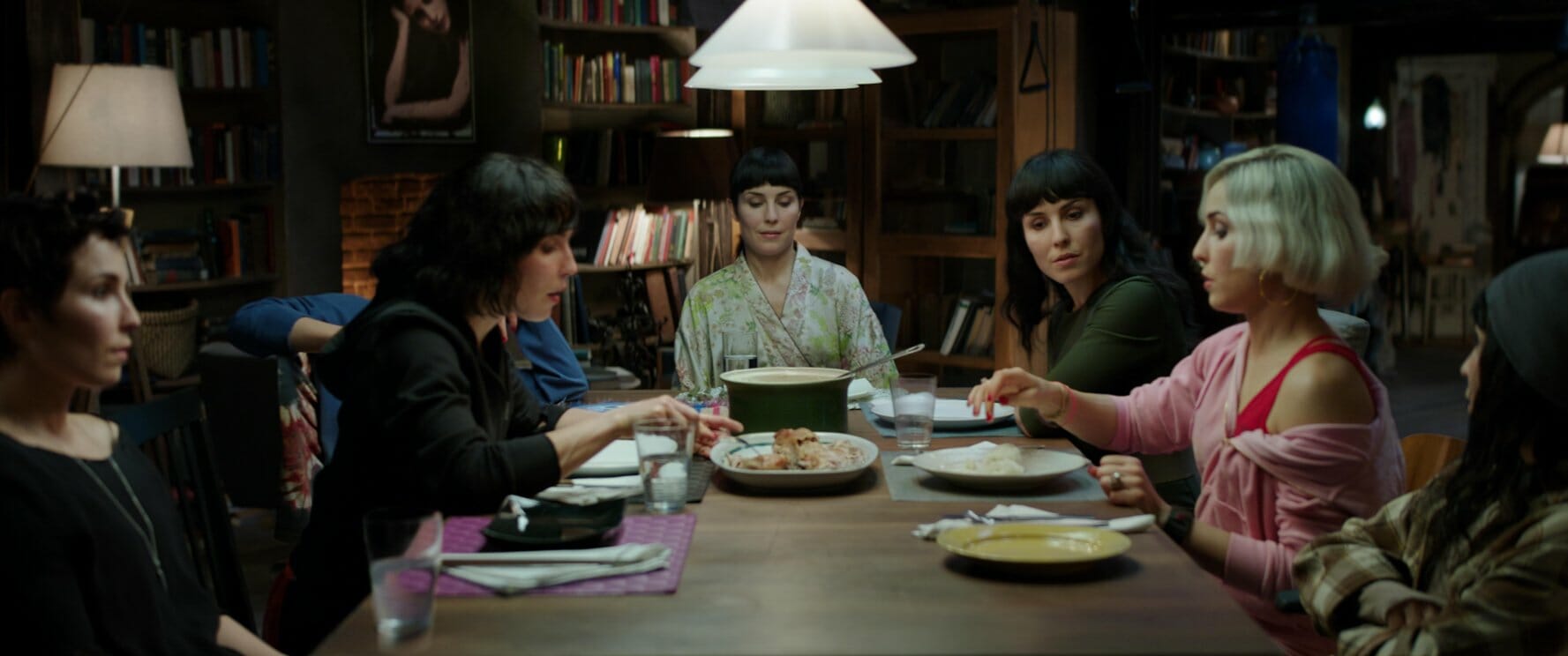The opening scene of the dystopian sci-fi thriller What Happened to Monday, directed by Tommy Wirkola, points straight to the root of the problem that sets the premise in motion: overpopulation. The year is 2043, and the world has come to yet another major crisis. As the movie starts, viewers are presented with scenes of overcrowded subways, streets, and even beaches. Climate change has disrupted crop production on a global scale. There is not enough agricultural output to feed everyone everywhere. Governments and scientists around the world think they have found a method to solve the issue. They use genetically-modified crops to maintain a steady supply of food, but the products end up causing a spike of multiple births, and fast-tracking overpopulation to further escalate the food shortage problem.

Governments worldwide initiate a one-child policy as a measure to tackle the problems of overpopulation. No family anywhere is allowed to raise more than one child. Assigned to control and oversee the policy implementation is the Child Allocation Bureau headed by Dr Nicolette Cayman (Glen Close). Any family with two or more children must pick one child to keep, and the siblings will be put to sleep in cryogenic chambers indefinitely, or at least until the population returns to a more manageable number. Every citizen is required to wear an identification bracelet. Checkpoints are scattered all around to make sure no one breaks the law.
Karen Settman
What Happened to Monday, now streaming on Netflix, takes its first step into the plotline with a scene depicting the birth of septuplets in a nursery. The mother dies in childbirth, before having the chance to tell anyone who the father is. A doctor asks the newborns’ grandfather, Terrence Settman (Willem Dafoe), about how he will manage to raise all of them and at the same time maintain the secrecy of their existence. The grandfather has a plan in mind to circumvent the one-child policy. Since there are seven grandchildren, each is named a different day of the week. It is a good thing they are all female, so they can use a single cover identity: Karen Settman. Only one sister is allowed to come out of the house on the day that corresponds with her name.

Fast forward to 30 years, and the grandchildren are now grown-up women (Noomi Rapace) living under the same roof. Willem Dafoe and Glen Close deliver praiseworthy performances for their respective roles, but Rapace takes the biggest spotlight. The sisters, while physically identical to each other, are depicted as having their own unique personalities. Rapace has to portray seven characters, who project noticeably dissimilar mannerisms and outlooks to life.
It is impressive how each sister appears like an almost entirely different individual, despite being portrayed by the same person. While the film is given average reviews from Rotten Tomatoes and Metacritic, 59% and 47% respectively, Rapace’s delivery is almost universally accepted as a dazzling tour de performance. It is not just how well she plays the seven characters, but how easily she does it.
Familiar Style
The premise, or the film itself, is rather a standard conspiratorial thriller set in a futuristic world. Some notable scenes function like reminders of other popular cinematic works. For example, the cryogenic chamber observed during the earlier part of the film brings RoboCop to mind, whereas the chatter outside will make viewers think about Blade Runner. They are not copies, but more like admissions by a proud director of how those iconic titles inspire his work.

On a similar note, What Happened to Monday uses pretty much the same style as the Orphan Black series, in which Tatiana Maslany portrays the lead character Sarah Manning and her many clones. There are scenes where the clones are on the screen together. Maslany’s performance is also unmistakable. Like the Settman sisters, Manning and her clones have different characteristics and body language as well.
The good thing is What Happened to Monday doesn’t try to imitate the other films at all. It has distinctive aesthetics, most prominently with a naturalistic—almost grim—approach to design. Technology doesn’t render humanity powerless; it is just that the cryogenic chambers have frozen much of the population and the authorities have no clear plan to restore order. To continue putting newborns into a deep sleep for eternity is cost-prohibitive and will not solve overpopulation. Cryogenic tubes do feel logical, but only until everyone learns that governments use the term “frozen” interchangeably with “incineration.”
Effective Plot Points
With seven identical twins as the main characters, it should be easy to feel lost in the story. Again, thanks to Rapace’s brilliant performance, following the plot points is an effortless task. Everybody can tell Monday from Thursday, or any other day of the week, without getting a headache. It is also surprisingly uncomplicated to know who is doing what in the scenes.

A series of action sequences begins with the mysterious disappearance of Monday. After a busy search, the sisters realize they have become Cayman’s targets. From his perspective, the septuplets pose threats not to the world’s population reduction program, but mostly to his credibility as the head of the Child Allocation Bureau. What follows is a gradual development of explicit scenes: frequent deployment of the c-word, eye-gouging, face-smashing, knife-slashing, and head-shooting. It is Naomi Rapace sobbing over a lifeless Naomi Rapace. All in all, the film is quite a fetish and almost certainly a sci-fi blast.
Seven identical sisters that are so different. Strong acting combined with clever writing makes it work. Have you seen What Happened to Monday? What do you think of it?
Let us know. We’d love to hear from you.
Other things you might want to know about.
What government or countries have a child restriction policy?
According to deccanherald.com China, as of June 2021, has gotten rid of its two-child limit and announced that couples can have up to three children. China had a one-child limit until 2016.
Japan has an incentive program to encourage childbirth. They provide paid maternity leave, a monthly childcare allowance of up to 12 years, and grants. Japan is trying to get the population to 2.1 for stability. In 2019 and 2020 there were 1.3 births per woman.
South Korea offers childcare facilities and other incentives. On the third Wednesday of every month offices close early so that parents can spend more time with their children.
Turkey also has created many incentives for couples, including gold coins for first-time moms and allowing mothers to work part-time which is paid for by the government.
Vietnam has a two-child limit with a gap period of 3 to 5 years. India also encourages having 2 children with a gap period of at least 3 years between the two. Nigeria is seeking to reduce the current six children per family to four.
New Zealand, Sweden and Canada have lots of benefits for their citizens including childcare allowances, government contributions for contraception, and help with children with disabilities.
Go to deccanherald.com and read this article called ‘Here are a few countries that have child policies.’
What actors have played the part of multiple characters in a film or show?
According to buzzfeed.com, there are 15 actors who have played more than one role in the same film or show.
- Robin Williams in Mrs Doubtfire
- Eddie Murphy in The Nutty Professor/Norbit
- Lindsay Lohan in The Parent Trap
- Martin Lawrence in Big Momma’s House/Martin
- Halle Berry in Cloud Atlas
- Nancy Cartwright in The Simpsons
- Shawn and Marlon Wayans in White Chicks
- Amanda Bynes in She’s the Man
- Nicholas Cage in Adaptation
- Tyler Perry in A Madea Homecoming, or any Madea Film
- Vanessa Hudgens in The Princess Switch
- James McAvoy in Split
- Jaleel White in Family Matters
- Seth MacFarlane in Family Guy
- Jamie Foxx in The Jamie Foxx Show
Go to buzzfeed.com to read more about each of these films or shows.
How does a cryotherapy chamber work?
According to cryoaction.com cryotherapy can be described as “cold therapy” for your body and skin. One of the most common types of cryotherapy is whole-body therapy, which involves exposing your entire body to temperatures that range between -100 degrees C and -160 degrees C for unique therapeutic purposes. It usually takes place in a chamber referred to as the cryo-chamber.
Your body goes into some sort of transformation when you step into the chamber. Your temperature drops dramatically for a few minutes. The treatment and recovery process is straightforward. The drop in temperature happens with the cooling power of liquid nitrogen and electricity. Once the temperature drops you are expected to stay in the chamber for at least 3 minutes before coming out. This is more comfortable than jumping into an ice bath. When you step into the cryo chamber, temperature sensors in your body send messages to your brain that trigger a fight-or-flight response.
When your brain senses the extreme cold, it causes blood to flow to the torso to insulate and protect all the vital body organs. When you step out, oxygenated blood rushes to the body’s organs, and this helps the healing process.
People who suffer from severe joint pain, rheumatoid arthritis, and even depression claim that whole-body cryotherapy helps alleviate their symptoms. Athletes claim it helps to improve their performance because it speeds up muscle recovery. Research has proved that cryotherapy has a positive effect on soft body tissues and tends to slow down muscle soreness.
Go to cryoaction.com to read more about cryotherapy and cryotherapy chambers.
If you enjoyed this then try out our other articles as well! https://storiesatworldsend.com/the-girl-with-all-the-gifts







